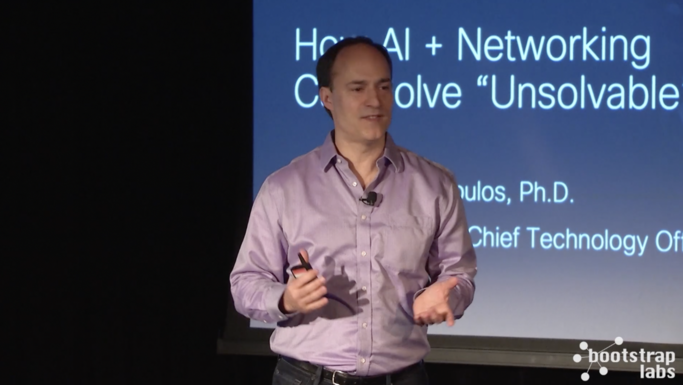Flashback: BootstrapLabs Applied AI Conference – How AI + Networking Can Solve “Unsolvable” Problems
The BootstrapLabs Applied Artificial Intelligence Conference 2019 #AAI19 brought together the brightest and most experienced experts in the field of AI for an immersive day of learning, discussion, and connection.
On BootstrapWorks we have released the videos from this past conference to relive the moments and spread the knowledge around the diverse topics covered by our experts on stage.
BootstrapLabs has built a community of more than 40,000 people from over 60 countries who care about applying Artificial Intelligence to solve the hardest problems of our society.
Get access to practical wisdom on Applied AI methodologies and take advantage of AI’s powerful potential, sign up here to receive the videos directly into your inbox.
Though Applied AI is widely known for its role in facial recognition and self-driving technology, few people think of AI when they think of computer networks. As computer networks become increasingly complex, encrypted, and under attack, machine learning and applied AI is well situated to support keeping networks safe while maintaining privacy. From finding malware in encrypted traffic without decrypting the traffic to moving from Cloud-based ML to distributing ML across Edge and Cloud, applying ML and AI to computer networks can lead to improved scalability, cost, and privacy. Join VP and CTO of Cisco’s Enterprise Networking Business, John Apostolopoulos, as he discusses the next generation of computer networking.
Speaker: John Apostolopoulos, VP/CTO of Enterprise Networking, Lab Director of Innovation Labs, Cisco
Some of the key takeaways from the session are:
- Cisco uses AI to:
- count people to automate processes in buildings or to display individual names in video-conferencing.
- detect and classify irregular noises to propose muting audio during video calls.
- identify problems in large networks and propose solutions.
- identify which devices are on the network to increase efficiencies, reliability and security.
- identify malware in end-to-end-encrypted traffic without requiring decryption.
- Reasons for moving AI processes to the edge of the network (instead of in the cloud or at the client side):
- In video analytics, sensors create plenty of data even with compression
- Cloud-based ML has issues with bandwidth, latency and privacy. If we move execution and learning to the edge we gain reduced bandwidth, improved scaling, lower latency and privacy-preserved learning. The question that many institutions research is how we can aggregate learning across multiple edges.
- Cisco achieved privacy-preserved learning with AI at the edge by generating synthetic images of people that captured the key attributes needed by the AI agent but preserved the privacy by anonymizing the images.
- We need more of these tools that analyze if a system successfully preserves privacy. If we jointly design networking and AI carefully together, we can solve a lot of current issues and provide the base for new technologies like AR/VR, autonomous vehicles, blockchain and smart cities.
About John Apostolopoulos:
As VP and CTO of Cisco’s Enterprise Networking Business, John Apostolopoulos is designing the next generation of computer networking. His work includes wireless (from WiFi to 5G), Internet of Things, multimedia networking, visual analytics, and machine learning. John is an IEEE Fellow and was named “one of the world’s top 100 young innovators” by MIT Technology Review, and contributed to the US Digital TV Standard (Engineering Emmy 1997). He published over 100 papers, receiving 5 best paper awards, and about 75 granted patents. John was a Consulting Associate Professor at Stanford and received his B.S., M.S., and Ph.D. from MIT.



